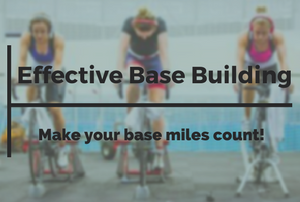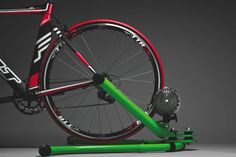When you hear the term “cycling base training” many of you think of cycling base training, involving long slogs through frozen tundra and icy winds. Those of you who are racers or competitive fondo riders may believe that the necessary base miles for competitive cycling are long, boring and low intensity, with little variety. Other, more recreational riders may think about watching the Tour de France while they spin away on the indoor trainer for a couple hours per week, hoping to get a jump on their group riding buddies. I've got a newsflash for you: those impressions are OLD SCHOOL and couldn't be further from the truth.
In reality, base training should be taken to it's most primal definition, one that's hidden within the term itself. “Base training” should be the activity done to build a solid BASE for your future fitness, both on and off the bike.
Just like the base of the human body is the core (everything attaches to it, everything works through it, so it's the true base of the body), the base of your fitness involves the core and everything contained within it, including your heart, lungs, and cardiovascular system. As an extension of your core, your legs have something to do with this too. Since they're the stems that attach your core to your pedals and they are important to build a base of fitness for as well. So it's not just accumulating saddle time that should be your focus (although you really do need saddle time), but what you do WHILE accumulating saddle time.
In this episode of the Tailwind Coaching Podcast, I'll talk about the importance of base training and how you can be more effectively base training than you are now.
Read more after the jump, including:
Podcast: Play in new window | Download (Duration: 1:04:34 — 88.7MB)
Subscribe: RSS
Effective Cycling Base Training
@8:27 – I'll talk about how traditional cycling base training involves “long slow distance miles.” It really involves targeted interval work, force development on and off the bike, muscular endurance work and neuromuscular skills. I'll break down Friel's Triangle and how neuromuscular skills fit in the base period.
Friel's Triangle and Effective Off Season Training
Strength training for cyclists part 1 and part 2
@30:03 – Discussion about endurance as a part of every ride no matter the objective. More about long-term base building, the importance of building neuromuscular skills during the base period, how force development plays into the base phase, and why you need more ME (Don't overdraw your “bank account.”)
@52:18 – I'll give you key tips for a successful base phase, including examples of ME intervals, neuromuscular skills intervals, force (gym/bike) intervals, and a couple of endurance enhancing tips. That's followed by a short segment on how HIIT (high-intensity interval training) 1-2x/wk can be effective. Further discussion about efficient bike position, body position, body mobility, and core stability.
Here's the key point
Base miles for competitive cycling do not have to be high volume, just efficient. It doesn't matter if you're training for group rides, gran fondos or races.
If you enjoyed this episode, click through to the Tailwind Coaching Podcast on iTunes and rate it 5 stars. A positive review helps the podcast move up the ratings, reach more listeners, and help more people get stronger, faster and fitter. Don't forget to post any questions to the Tailwind Coaching Facebook page, and don't forget to support our sponsors and help to keep this podcast free, help me to get this information to more people and help grow the cycling community.
If you're not training for the coming season, what are you waiting for?! Pick up your training plans for this season by checking out my modular training plans in my online store and think about building some “Raw Strength” with my new 8 week strength training plan. If you're looking to add more pop to your pedal stroke, consider picking up my new Advanced Base Module and get on the road to more power and finesse!
Want more tips like these? Subscribe to the Tailwind Coaching Newsletter!

